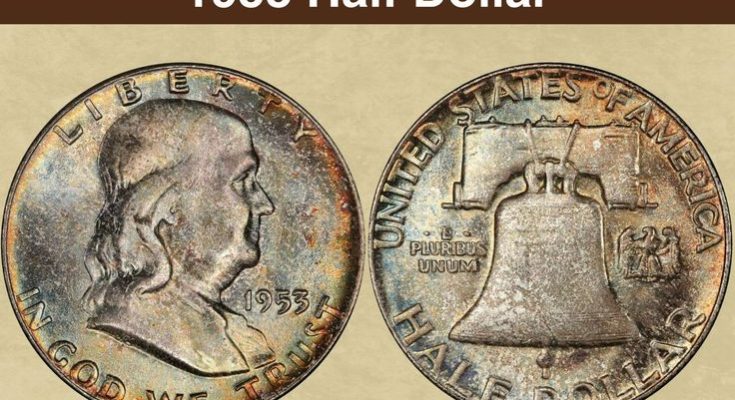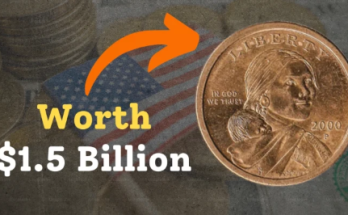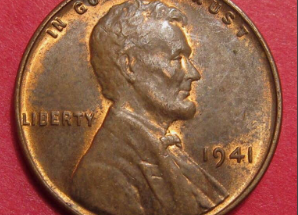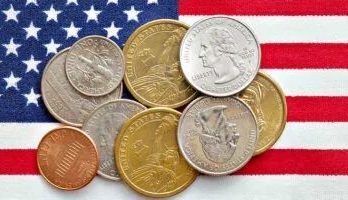Coins from some minting years are worth much more than their face value but how do you know which years are more valuable than others? And how do you identify the valuable specimens? For example, what is the value of a 1953 half dollar?
Half dollars from 1953 can sell for thousands when in mint condition. We explore the different mint varieties of 1953 half dollars and what they are worth. You will also find information on how coins are graded and errors on the 1953 half dollars that may increase the coin’s value.
1953 Half Dollar Value Chart |
|||||
| Mint Mark | Very Good VG8 | Extra Fine EF40 | Uncirculated MS60 | Uncirculated MS65 | Uncirculated MS67 |
| 1953 No Mint Mark Half Dollar Value | $16 | $16 | $26 | $125 | $2,350 |
| 1953 D Half Dollar Value | $16 | $16 | $22 | $100 | $4,250 |
| 1953 S Half Dollar Value | $16 | $16 | $34 | $70 | $1,350 |
The 1953 half dollars belong to a series known as Franklin half dollars because it features a portrait of Benjamin Franklin on the obverse. The Franklin half dollar was first minted in 1948, replacing the previous Walking Liberty half dollar design.
The Franklin half dollar was designed by John R. Sinnock, who was the Chief Engraver of the US Mint at the time. Before the Franklin dollar, Sinnock had designed the Roosevelt dime released in 1946.
However, the Franklin half dollar was not finished before Sinnock passed away in 1947. Gilroy Roberts, who was the assistant engraver and had already collaborated with Sinnock on the design, completed the work. Roberts was later promoted to the role of Chief Engraver, becoming the ninth Chief Engraver for the US Mint.
When the new half dollar design was shown to the Commission of Fine Arts, they were not impressed. While some of the critics felt the design was too plain and lacked artistic flair, others objected to the use of a person who was not a president on a US coin.
The design on the reverse drew the most criticism. The Commission said the eagle was too insignificant and small next to the bell. They also feared that the cracks on the liberty bell could cause ridicule and puns from the public. But perhaps the worst part was the rumors that Sinnock had included a Communist symbol in the design, which led to a congressional investigation.
These rumors were based on the initials JRS under the cutoff at Franklin’s shoulder. Some said they stood for Joseph Stalin when they stood for the designer John R. Sinnock. The rumors were quelled when it was pointed out that Stalin’s middle name did not begin with R.
However, because the Commission was not happy with the design, they suggested holding a competition to find a new design. However, Treasury Secretary John W. Synder didn’t agree with the suggestion or the objections and approved the Franklin half dollar design and production started the same year.
1953 Half Dollar Grading
The grading system for coins uses a scale that starts with PO1 for the poorest condition coins and finishes with MS70 for the perfect coins. Coins graded between 1 and 59 are circulated coins with different levels of wear and tear.
The highest circulated grade is AU58, meaning about uncirculated, given for coins that are almost as good as uncirculated coins. Grades 60 to 70 are for uncirculated coins and use the letters MS, meaning mint state.
| # | Grade |
|---|---|
| 1 | Basal State-1 |
| 2 | Fair |
| 3 | Very Fair |
| 4, 5, 6 | Good |
| 7, 8, 10 | Very Good |
| 12, 15 | Fine |
| 20, 30 | Very Fine |
| 40 | Extremely Fine |
| 50 | About Uncirculated |
| 60 | Mint State |
| 65 | Mint State |
| 70 | Mint State |
Please check our grading guides to know your coin scale, It’s the necessary step to know the exact value of your coin.
If you are still unsure about the price of your coins, you can appraise and sell your coins for free through our verified platform.
1953 No Mint Mark Half Dollar Value
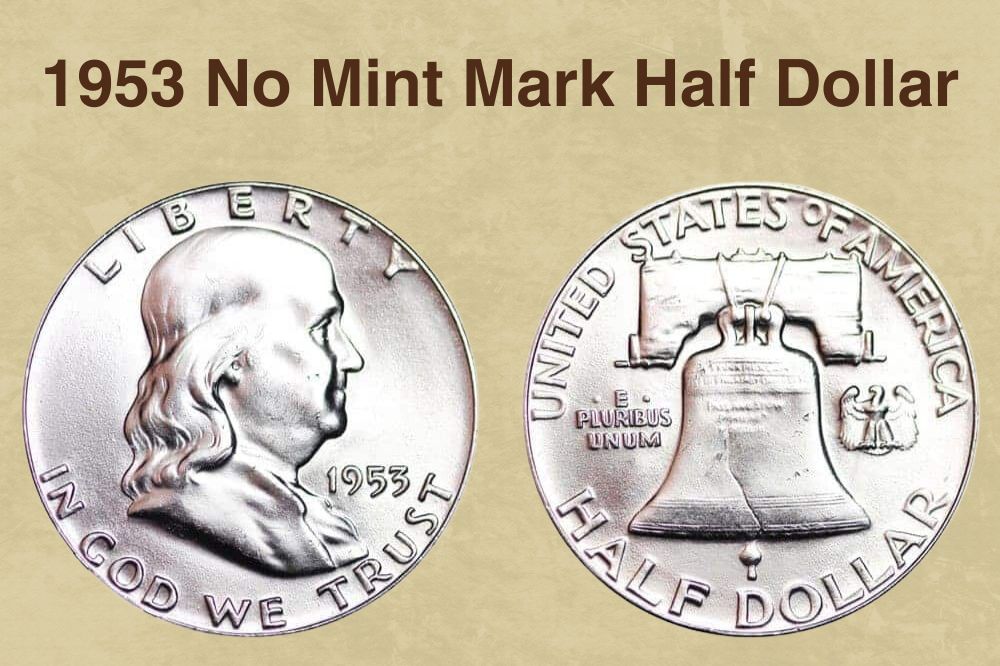
1953 half dollars in Philadelphia are called the no mint mark variety because, unlike the other two, there is no mint mark on them. In 1953, half dollars were minted in Philadelphia, Denver, and San Francisco and the Philadelphia Mint produced the lowest quantity with 2,668,120 half dollars minted at the Philadelphia facility.
Because most of the half dollars minted in Philadelphia in 1953 have been in circulation, they show signs of wear and tear and this is reflected in the value. No mint mark half dollars in good condition are worth around $16 and the extra fine is about $16.
The values start to climb sharply when the coins are valued at MS65 or higher. A 1953 half dollar graded as MS65 is worth $125, while an MS67 half dollar is valued at $2,350.
The auction record for a 1953 no mint mark half dollar is from June 2020. It was achieved with an MS67+ graded coin at a Stack’s Bowers sale. The price guide for the coin was $4,350 and it sold for $4,080.
The Obverse Design of the 1953 Half Dollar
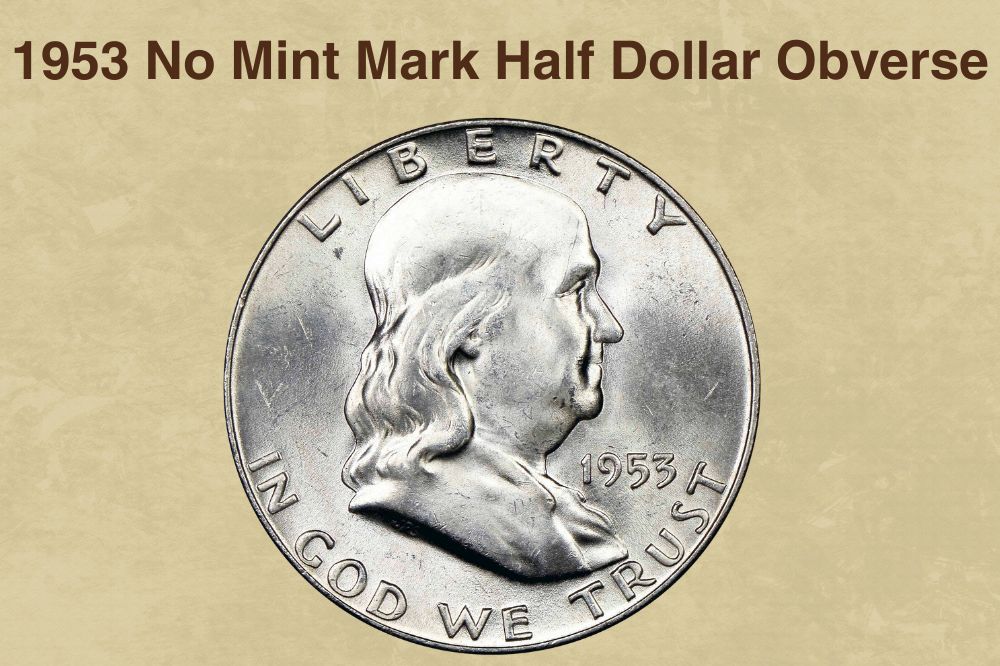
On the obverse of the coin, is the portrait of Benjamin Franklin. The designer, John R. Sinnock, based the portrait design on a bust of Benjamin Franklin created by Jean-Antoine Houdon in the 18th century.
Franklin’s portrait in the center is facing to the right and the minting date is in the front of the portrait, right below his chin. The phrase IN GOD WE TRUST curves along the bottom rim below the portrait and the word LIBERTY along the top rim above the portrait. The initials, as mentioned above, are at the shoulder cut-off.
The Reverse Design of the 1953 Half Dollar
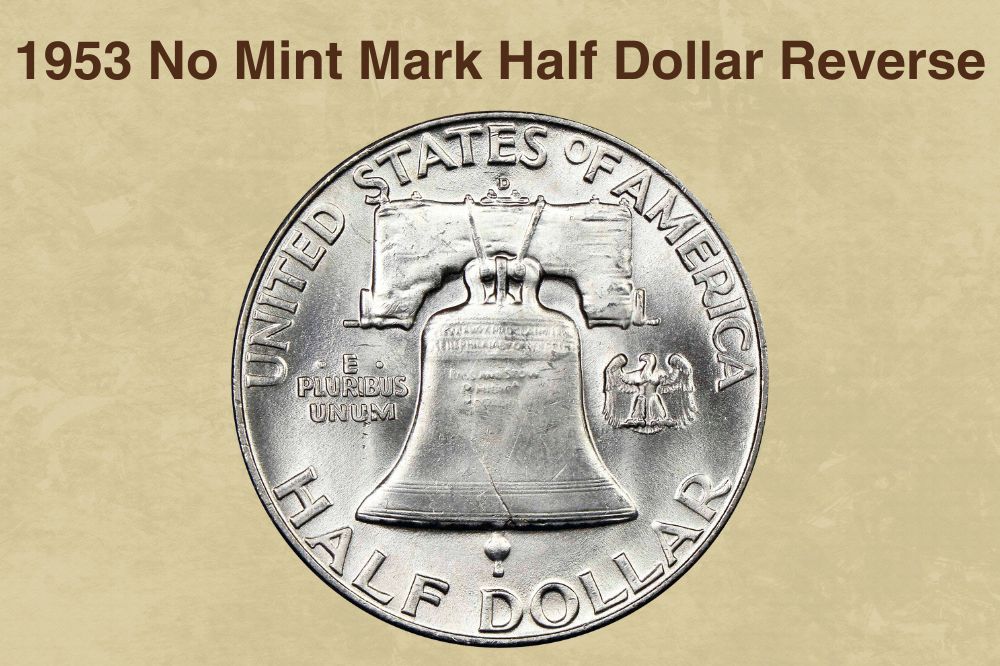
While the obverse was Sinnock’s work, it was on the reverse that Gilroy Roberts had more input. The design features the Liberty Bell in the middle and it is tied to a wooden beam. Where the bell widens at the bottom, are two sets of horizontal lines. Each set has three parallel lines. There is also lettering on the shoulder of the bell.
The mint mark, as mentioned, is on the reverse, above the wooden beam, and below the letter E. To the right of the bell is the small eagle, which is mandated by law. According to the Coinage Act of 1792, an eagle should appear on the reverse side of American gold and silver coins.
The country’s name UNITED STATES OF AMERICA runs along the top rim of the coin with the letter O in a slightly smaller font. The Latin phrase E PLURIBUS UNUM is on the left side of the bell at the same height as the eagle. The HALF DOLLAR denomination is along the bottom rim.
Want to Find the best coin dealer near you? Here we can help. (with customer reviews and Rating)
Other Key Features of the 1953 Half Dollar
There were 27,974,020 half dollars minted in 1953 across the three mint facilities. The coins are composed of 90% and 10% copper. They weigh 5 grams and have a diameter of 30 millimeters. The coins are round with a reeded edge.
1953 D Half Dollar Value
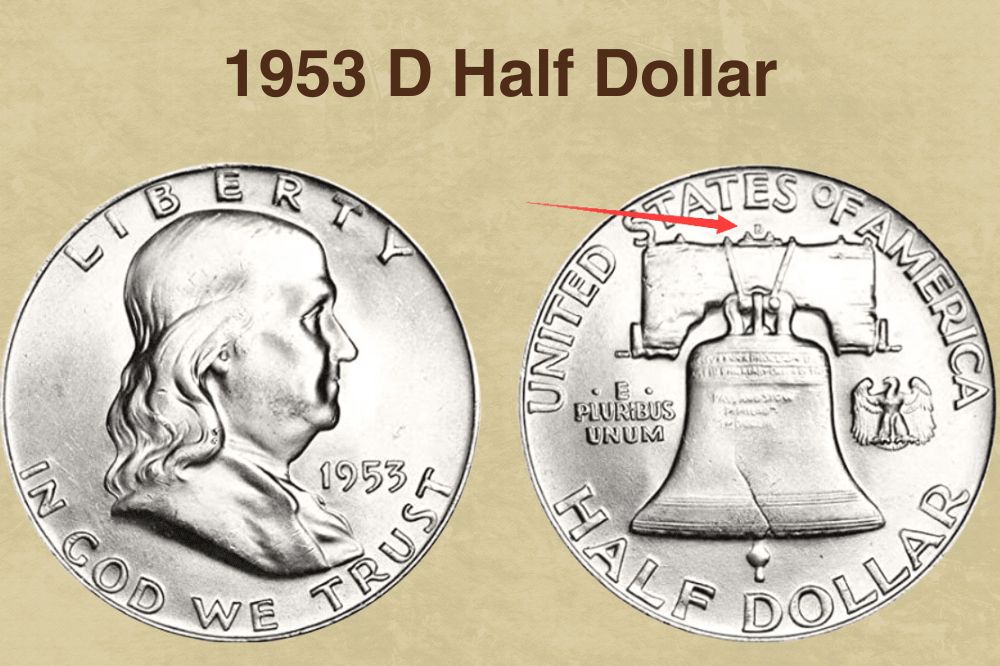
In 1953, the Denver Mint produced the largest number of half dollars, releasing 20,900,400 into circulation. You can identify Denver minted half dollars from the letter D on the reverse. It is located top center, below the letter E of the word STATES.
Interestingly, it is the D minted 1953 half dollars that are the most valuable at higher grades. Why is that when there were so many more coins minted in Denver than at the other two facilities?
The reason behind the high valuation of the 1953 D half dollars at MS67 is that these high-graded coins are rare. While there are millions of coins available at lower grades and even MS65 graded D half dollars from 1953 are not particularly rare, very well-preserved specimens are hard to find.
When graded at MS67, 1953 D half dollars are graded $4,250. The auction record sits roughly between these valuations. It is from 2005 when an MS67 graded 1953 D half dollar sold for $17.250 at a Heritage Auctions sale.
1953 S Half Dollar Value
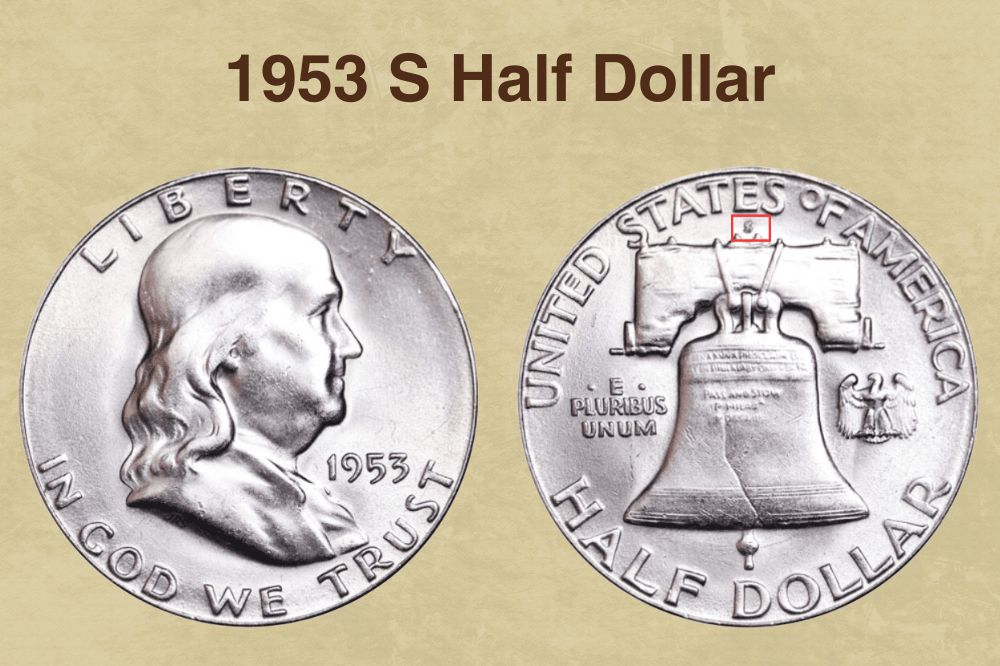
The San Francisco mint produced 4,148,000 half dollars in 1953, which can be identified from the S mint mark on the reverse. The 1953 S mint half dollars have the lowest values of all three mint varieties at uncirculated grades. This is again to do with the easier availability of higher-graded coins.
While S-minted half dollars are valued slightly higher than the other varieties when graded extra fine or MS60, their values fall behind at MS65 and even more at MS67. An MS65 graded 1953 S half dollar is worth around $70 and an MS67 around $1,350.
However, this doesn’t mean the coins cannot sell for more, and sometimes, at the right sale and right time, you can get surprising results. The auction record for S half dollar from 1953 is higher than for a no mint mark dollar. The record is $6,000 for an MS65-graded coin from 2022 sold by David Lawrence RC.
Strike Quality and the 1953 Half Dollar Value
When a Franklin half dollar is sent for grading, one of the criteria includes the strike quality of the coin, which refers to the level of detail and sharpness present in the design elements of a coin. It is a measure of how well the die has transferred the design to the surface of the coin.
Coins with a high strike quality have sharp, well-defined design elements, while coins with a low strike quality may have softer, less-defined design features. The strike quality can be affected by, for example, the condition of the die, the force applied, and the quality of the planchets. Well-struck coins are more desirable than those with low-strike quality.
If you are still unsure about the price of your coins, you can appraise and sell your coins for free through our verified platform.
On the Franklin half dollars, the strike quality can be examined by focusing on three design elements on the reverse. A coin with high strike quality will have clearer lettering on the bell, visible parallel lines at the bottom of the bell, and more detailed lines on the eagle’s wings. On lower-quality coins, these details will be faint or they may not be visible at all.
Rare 1953 Half Dollar Error List
1953 Half Dollar Full Bell Lines
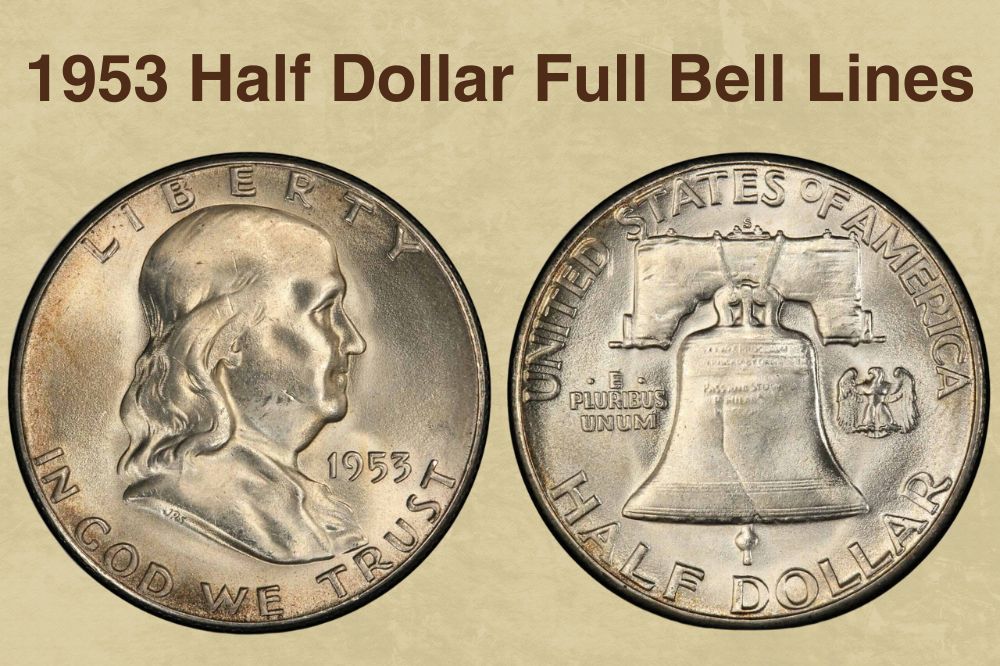
Strictly speaking, this is not an error, but since it makes the coin rare, we have included it on the list. Full bell lines (FBL) refer to coins that have all the horizontal lines on the bell visible and fully separated. A coin can only get the FBL designation when there are no cuts or marks on the separation of the lines.
These coins are rare because a coin can lose its FBL designation easily. Even when the coin has crisp, clearly defined details, it will not qualify if there are any surface imperfections from wear and tear. FBL 1953 half dollars can fetch much higher prices from collectors and the auction record, from 2001, is $69,000.
1953 Half Dollar ”Bugs Bunny” Error
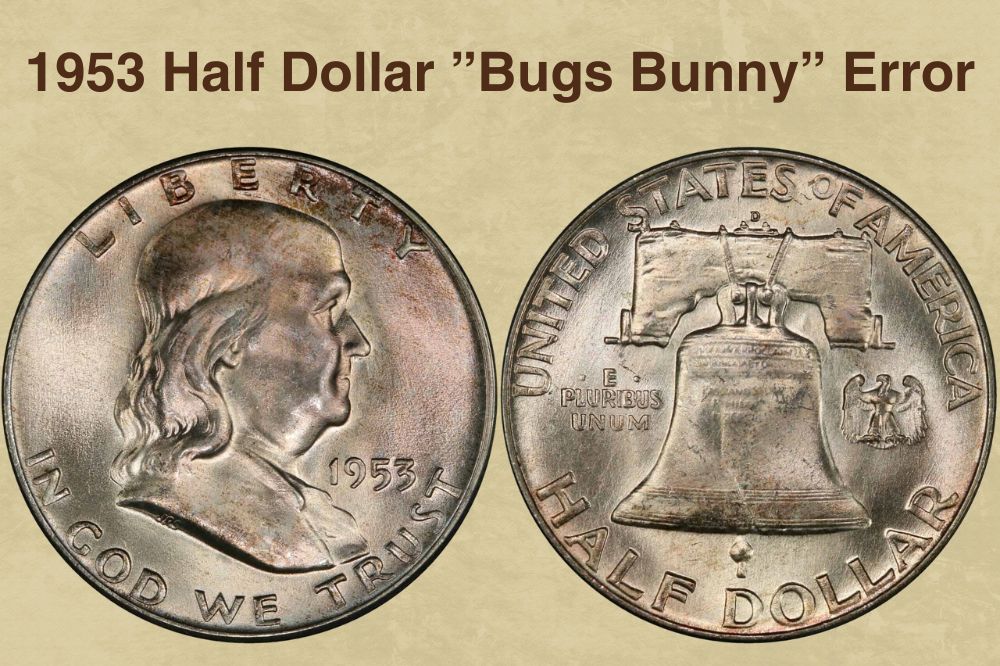
Some rare 1953 Franklin half dollars have been nicknamed Bugs Bunny half dollars because of a line projecting from the upper teeth. The line makes it seem like Franklin has buck teeth like Bugs Bunny and was caused by a die clash.
In a die clash, the opposing dies strike each other and the reverse is transferred on the obverse. On the 1953 half dollar, the line on the teeth is caused by a detail from the eagle’s wings on the reverse.
Want to Find the best coin dealer near you? Here we can help. (with customer reviews and Rating)
While the error is relatively rare on the 1953 half dollars, the coins are not valued anywhere near as high as FBL coins. While often graded above $100, the exact value depends on a range of factors including the overall condition of the coin.
Also read: 13 Most Valuable Kennedy Half Dollar Worth Money
Where to Sell Your 1953 Half Dollar ?
Now that you know the value of your coins, do you know where to sell those coins online easily? Don’t worry, I’ve compiled a list of these sites, including their introduction, pros, and cons.
1953 Half Dollar Frequently Asked Questions
Is a 1953 half dollar made of silver?
Yes, the 1953 half dollar is made of silver. Half dollars minted from 1948 to 1963, which include the 1953 half dollar, were composed of 90% silver and 10% copper. Therefore, these coins are often referred to as “silver half dollars” or “90% silver half dollars”.
What is a 1953 silver dollar worth today?
The value of a 1953 silver dollar depends on various factors and there is no single price for all half dollars from that year. While coins that have been in circulation and are in good condition may be valued at around $9, highly graded 1953 half dollars can be worth thousands of dollars.
